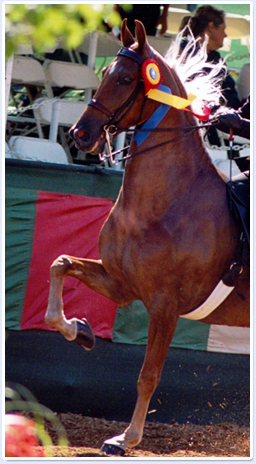Nealia's Articles
Cross Roads
By Nealia McCracken
Stepping into the new millennium with new rules especially written for the American Saddlebred Country Pleasure western horse brings us to a crossroads in not only our attitude but in the way we show American Saddlebred’s in the Western Division. Over the years one phrase keeps coming up over and over that “haunts” me, that phase is that we need to follow the traditional western breeds. I am assuming that by saying traditional western breeds these people mean mostly the American Quarter horse, Appaloosa or Paints since the Morgan’s and Arabians which were bred for a totally different purpose than western riding. At this point I would like to interject a thought. Have we ever as a traditional saddle seat breed (we are the original one and designed for our breed) cared what rules and standards any other breed has done with their saddle seat division (i.e. shoeing, head set, way of going, gaits,equipment, or classes in a show)?? Not that I have heard. If other breeds want to regulate shoeing or change the headset to enhance the natural conformation of their breed, then so be it. Why would we as Saddlebred owners care if the Appaloosa breed, as an example, were shown with a lower head carriage in their saddle seat division to meet their conformation breed standards?
After hearing numerous comments on Saddlebreds looking and working like the traditional breeds; i.e. Quarter horses, I have made a point of watching as many Quarter Horse, Appaloosa/Paint, Arabian and Morgan western classes as possible. [One of the points that I have observed is that in trying to achieve this “traditional western look” the exhibitors are constantly adjusting, two handing, mouthing up by elevating their hands to an extreme level and after dropping all contact to the horses mouth, or see-sawing the horses mouth to get them to drop their head (i.e. training their horses) in the show arena when the judge is not looking.] The rules for all western classes when riding in a western curb bit clearly state that riding two handed is cause for elimination. Does this mean the rules only apply when the judge watches? In other words these people ride for only 1 or possible three individuals, the judges. They appear to not care what
the spectators see them do to get that winning traditional western ride. I AM NOT CRITIZING ANY OF THESE PEOPLE –I’M ONLY MAKING AN OBSERVATION. What they do in their breed as long as its not abuse is up
to them. It is the American Saddlebred horse that I have chosen to own, train and love. Those are the one’s I care about.
In thinking back on the many Shatner finals that I have watched one thing jumps out at me that I am extremely proud of that has been carried over from the saddle seat divisions. We ride the American Saddlebred not only for the judges, but also for the approval of the spectators. I have stood on the rail year after year, class after class, and watched hundreds of
western Saddlebreds make flawless rides to be seen by anyone no matter where they were standing around the arena. A huge Bravo to all these riders! I teach my riders to always strive for total perfection in their ride whether at home or at a show. I work my horses in a similar fashion by working them to be the best they can be as God intended that individual
to be. If they have a low natural headset I ask them to carry it the best they can and no more. On the other hand if they have a naturally high head carriage they also are worked in a fashion that allows them to carry it naturally. I never force my horses into a standard that is totally man made and is not to their natural individual conformation. The result is a horse and rider “TEAM” that presents a picture of pleasure and perfection to anyone that is watching. To watch the best American Saddlebred’s in the world at the Kentucky State Fair you see they are ridden not only to please the judges, but the thousands of spectators in the stands. The spectator’s approval is so important to the American Saddlebred industry that countless ads have been placed in national breed magazines claiming their horse was the crowd’s favorite. There are even People’s Choice awards. I want my western horses to have that same respect. I am proud of any type of influence that I might have had on the western division as it is ridden now. I hope that we can stop worrying about trying
to be like the traditional western breeds and using rules that do not apply to our standards.
Any time you train any breed of horse for a particular task you will run across problems that you have to solve to have the horse perform your task. The AQHA rules, (that I will repeat again is a traditional western breed), want the neck in a straight line from the withers to the pole with a head carriage that is neither too high nor low. Too low for that breed
being the tips of the ears that are lower than the withers for more than so many strides. Their nose is to be not too far in or out. In their rules they also state to penalize stumbling and lethargic horses. The horse is to move at a slow rate of speed with a loose rein. How do you get a horse to drop its head to carry it straight and lower or raise it on a loose rein? Some of the methods are lunging a horse until they are tired or possibly using types of tranquilizers, which several trainers of world class western horses (not Saddlebreds) got busted for at the world finals several years ago. This may explain why stumbling and lethargic horses require penalizing, as there have been many of them. Why do we want this set of problems added to our breed so they can personify the traditional western way of going? Possibly a key word that should guide us when we consider what rules should influence our breed in the western division is “stock type” vs. “saddle type”. Our breed is not a stock type breed. Why would the rulebook differentiate stock type if all breeds were to be worked exactly the same? The American Saddlebred rules call for collected horse and gaits; they allow our horses to show with natural motion and should not penalize a low-headed western horse. Collection cannot be obtained on a totally loose rein. A horse cannot set their head and travel as required with absolutely no contact to the mouth. If we expect our horses to be ridden on a loose rein we are also going to be faced with adding to our rules that lethargic and stumbling horses to be penalized. Why should only one of our divisions of our breed not look proud, collected, alert and be the epitome of a show horse, as the breed standard requires. Why should the western division be the only division in the American Saddlebred breed that does not characterize the American Saddlebred standards?
Let’s push for rules and standards for the American Saddlebred Western Division that enhance our horses and the breed standards that allows us to safely and humanely show our horses to their best and to everyone that is watching. Let’s not imitate other breed’s standards just because they have more western horses than we do. Let’s not have our western division look like a “ reject “ saddlebred class that is trying to imitate the traditional stock type standards. I am not inferring that the other traditional western breeds are rejects. I am merely stating that turning our Saddlebreds into the stereotypical western pleasure horse is going directly against our breed standards. To the best of my knowledge, I have never seen in the AHSA magazine any of the American Saddlebred western exhibitors getting written up for use of tranquilizers, excessive cruelty (i.e.use of blocks of wood in mouth), hanging a horses head up and bleeding them. Nor have I seen at shows designated lunging areas so that we can lunge the horses to the point of exhaustion so that the horses will work to achieve the performance required by the traditional western standards. I am not ashamed of my training methods (at home or at a show) nor have I witnessed inhumane training practices from other American
Saddlebred trainers and exhibitors. In closing I would like to say that I am so proud of my Western Saddlebredshow horses that I haul these horses all over the country to Equitana, parades, and breed demonstrations, wherever possible. So far every non-Saddlebred horse person that has ridden one of my western horses not only thinks they are beautiful to
watch but also they are absolutely the most comfortable horse to ride. Isn’t that what our breed was originally breed for—beauty and comfort?




